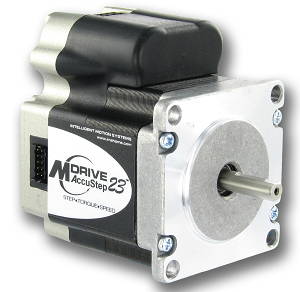Control technology `makes steppers preferable to servomotors`
The US brushless motor specialist Intelligent Motion Systems has developed a control technology for stepper motors that, it claims, could make them preferable to more expensive servomotors for most applications requiring brushless motors.
IMS’ Accustep technology prevents steppers from losing synchronisation as a result of transients, overloads, extreme acceleration or deceleration, or excessive slew speeds. Such losses of synchronisation, which occur when a large load exceeds the motor’s capacity to resynchronise once the load is reduced, have previously been considered on of the stepper motor’s biggest limitations.
“With AccuStep, there is now a low-cost alternative where brushless technology is required,” says Max Wietharn, IMS’ vice-president of sales and marketing.
When steppers reach a certain point on their speed-torque curve, they lose the ability to restart if a load is applied that becomes greater than the motor’s ability to produce the required torque.
The AccuStep technology works by preventing the loss of synchronisation that occurs when the rotor lags or leads the stator by two steps. It uses an encoder to monitor the location of the rotor relative to the stator and if this equals or exceeds a set limit, the technology intervenes by “slowing” or “accelerating” the stator commutation speed to the same as the rotor, keeping the lead or lag within limits. This change in commutation speed continues until there is a change, either in the commanded motor speed or in the load requirements that allows the motor to create sufficient torque at the commanded speed.
The change in commutation speed can go on indefinitely, behaving in a similar way to a brushed DC motor. While this is happening, the difference between the commanded steps and the actual steps taken is stored internally. This difference can be read or cleared by a host controller, or the missing steps can be injected back into the system when sufficient torque is available.
Because the technology eliminates loss of synchronisation, it allows a motor to operate safely at its maximum torque curve. It is no longer necessary to size the motor with a 25–50% torque margin, and smaller frame or shorter stack motors can be used in some applications. The technology also allows a motor to ride through known transient overloads, further reducing the need for a larger machine.
IMS points out that the technology will not compensate for a poor design. It will not make a motor more powerful, but will maximise the capability of the system and make it more robust. To enhance performance further, variable current control can be enabled to limit phase current to that which is needed to perform a move. This reduces motor heating, and increases system efficiency.

IMS is offering the technology for two versions of its Nema 23 frame size MDrive integrated stepper drive (above). The first combines the control technology with the motor, microstepping driver and encoder to provide three operating modes: step and direction; torque control (which maintains constant motor torque set either in software or via an analogue input); and speed control (which delivers accurate velocity control with a choice of three input voltage ranges). The second version adds a programmable motion controller to provide full motion control.
IMS, owned by Schneider Electric, expects the integrated steppers to be used in applications such as point-to-point positioning, conveyor control, web handling, drilling, rotary and linear positioning to torque specification, and low-end camming. With the addition of torque control, rotary and linear positioning to torque specifications will be possible.





